| |
|
February 2015
|
Printing a nozzle
|
|
Mark is currently printing a preliminary version of the 10k nozzle. Later he will make a time laps video.  Video Video
|
^ top
| July 2012 |
SPL welcomes Devis Tonon in it's team |
We welcome Devis Tonon as a new team member. He holds a PhD in Applied Physics Technical University of Eindhoven) and a MSc in Aerospace engineering (Polytechnic University of Turin). He has experience in aeroacoustics, thermoacoustics and fluid dynamics. He will be a great help for us solving the thermoacoustic issues in one of our engines. |
^ top
| Sept 2011 |
10 kN engine at full throttle, modification on test stand |
Short summary: The engine ran on Ethanol/LOX, O/F about 1.95, thrust nearly a metric ton and we got a (measured!) ISP of about 232s at a chamber pressure of 21 bar... which is quite a good number! We pushed the chamber pressure further, but ended up with a molten nozzle (for optimizing combustion, short burning times are sufficient... so we only use mild steel nozzles at this state of the tests). More below...
Some history: Some months ago we further modified our test stand to improve the sound suppression of the sound suppressing tunnel to be prepared to test the new 10 kN engine. For this we added a water injection ring into the movable tube in which we fire the engines. This cools the tube and reduces the noise level about 10 dBA:
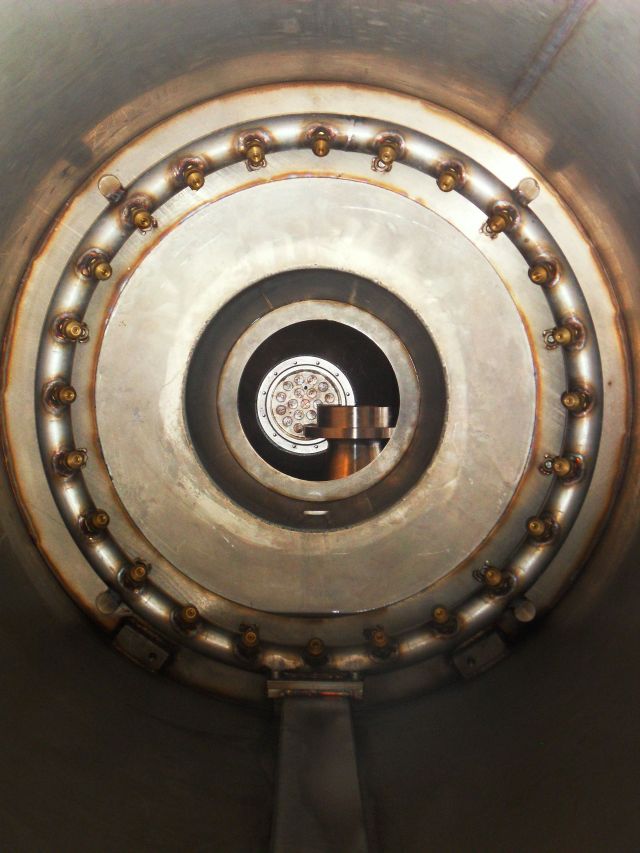 |
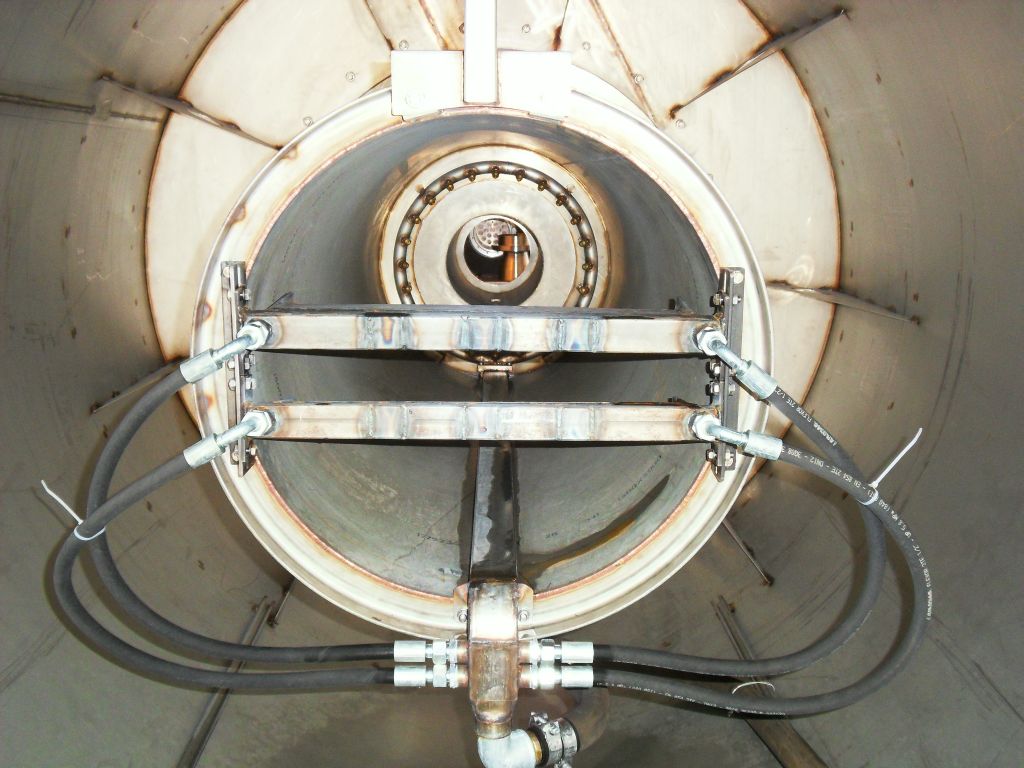 |
(At the end of the tube you can see the injector with removed nozzle)
At the downstream end of the tube we additionally mounted a pair of water cooled wedges. They produce a shock in the supersonic exhaust, slowing down the gas speed to subsonic. This reduced the sound level for nearly 20 dBA!. Now we can fire our 10 kN engine even at night ;-) This was also used in the silos of US-ICBM's and is covered in several patents like US5422443.
Then we fired the engine the first time (The date in the movie is
wrong). Ignition happens at the time 15:40:30. In the upper right frame
you see starting the water injection into the tube prior ignition.
 Video Video
We noticed a poor O/F of about 1.0 and found the source of the problem
in a collapsed LOX-Filter upstream of the LOX-main valve.
We removed it and fired the engine without it yesterday.
 Video Video
We increased the chamber pressure further and further and finally hit
the limit what the steel nozzle can handle:  High speed video with 600
frames/s. High speed video with 600
frames/s.
The nozzle showed some nice patterns of molten metal:

No damage to the rest of the engine or test stand. Only damage to the
engineers ego :-) We had a lot of fun yesterday! |
^ top
| May 2011 |
SPL tests 1 ton thrust rocket engine |
|
On
the 28 May, SPL run the one ton thrust liquid propelled rocket engine
(SLR 10k-I) for three times successfully.
We also tested our new
water cooling system, which reduces sound emissions and the temperature inside the sound absorber. The first tests
are part of a longer test programme of the SLR 10k-I. Have also a
look on our media page with press release and articles.
|
^ top
| April 2010 |
SPL meets Prof. Dr. Dr. Oliver Ullrich and Dana Simmet at UZH |
Isabell
Buttron and Adrian Mettauer, both PR & Marketing of SPL, got the
opportunity to visit the research laboratories of UZH's (University of
zurich's) Division of Space Biotechnology at Zurich-Irchel. There,
Prof. Dr. Dr. Oliver Ullrich, Adjunct Professor of Space Biotechnology
(UZH/University of Magdeburg) and Dipl.-Biol. Dana Simmet provided an
insight into their fascinating zero-g research.
After a tour
through the laboratories, where the effects of altered gravity forces
on cellular and molecular mechanisms are investigated, the SPL
associates received an introduction to the various scientific projects.
Amongst others, the scientists are performing experiments on board of
parabolic flights like with the Novaspace-owned Airbus A300 ZERO-G,
based at Bordaux/France. The aim of this research is to find solutions
to the various health-related problems astronauts are facing during and
after a mission under zero gravity conditions, such as a profound
decline in immune function, bone and muscle atrophy.
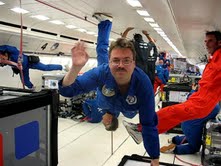 |
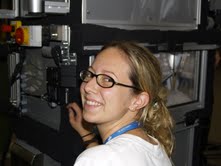 |
|
^ top
| 25.
January 2010 |
Mirage
III rocket engine was handed over to SPL |
|
SPL
bought a Swiss Mirage III SEPR rocket engine
from a private collector for a symbolic price.
It was handed over on the 15th January in La
Brévine (Jura). The engine had been developed
by the SEP (Société Européenne
de Propulsion) and was first tested in February
1962. It was used by the Mirage III as an additional
booster for tactical maneuvers like zoom climbs.
On the 15th of May 1963 a prepared French Mirage
III reached 26.06 km altitude and set an official
record for France, still standing today. Swiss
pilots flew the fully equipped Mirage III S
up to 24 kilometers until the 1980s. The Swiss
Air Force had used twenty engines from May 1969
to April 1990. They were license built by Hispano-Suiza
and had performed 2'170 rocket flights. SPL
has one of them, now.
The
liquid cooled engine could develop 15kN thrust
for nearly two minutes and could be re-ignited
in flight. It operated with nitric acid and
aircraft supplied kerosene. The ignition was
made with a hypergolic nitric acid TX2 combustion.
The chamber was fed by two centrifugal pumps
driven by an shaft coming from the aircraft
turbojet engine. The chamber is a saddle design
made of aluminum which can be completely disassembled
for maintenance. The chamber is cooled by the
nitric acid.
Records:
-
Holding the altitude record of France: 15.05.1963,
a Mirage III reached 26.06 km
-
most built aircraft rocket engine (275 built)
-
most used man-rated rocket engine (over 20'000
flights)
-
world record of manned rocket flights (over
20'000 flights)
-
world's most reusable rocket engine (average
of 35 flights between general overhaul)
-
round trip times < 15 minutes has been
demonstrated.
The
engine is a freshly refurbished one, just out
of the arsenal. We will not fire it again, but
we can learn a *lot* from its design and also
from the instructions for the operatinal ground
support. Most of it applies to the operations
of nowadays and intended rocket planes.
Two
AIAA Papers about the development:
The SEPR 844 Reusable liquid Rocket Engine for
Mirage Combat Aircraft, AIAA-90-1835
Reusable Man-Rated Rocket Engines, AIAA-43160-765
A
collection of pics when we inspected it
(some are from the museum in Le Bourget)
:
|
^ top
| 24. October
2009 |
Eugen Reichl, aerospace author, visited SPL |
|
Eugen
Reichl honored us with a visit of our facilities. He is a German
aerospace author and employee at the EADS Astrium. He published several
books and booklets, like the "Typenkompass; Bemannte Raumfahrzeuge;
seit 1960" (see all books on www.amazon.de). He also writes for the German space magazine "Raumfahrt Concret".
Have also a look on www.der-orion.com , the base-block of a multi-media spaceflight and astronomy portal operated by Maria-Pflug Hofmayr and Eugen Reichl.
|
^ top
| 23. September
2009 |
SwissCube - first Swiss satellite
successfully launched |
|
The first ever signals sent from a Swiss satellite
in space have been received in the Lausanne region. It’s a
unique moment for students, professors and of course the whole nation.
The satellite was successfully launched by the Indian PSLV-C14 this
morning (Swiss time). The first signals were heard at 12:20 from
California and the Netherlands. The Space Center Lausanne recognized
the call sign at 13:20 – so, all systems are running well.
SPL congratulates the SwissCube crew!
Related links:
|
^ top
| 9. Mai
2009 |
SPL, Talis Enterprise GmbH and the Space
Tourism Society - Malaysian Chapter (STS-MC) are signing a certificate
of cooperation |
|
The
certificate of
cooperation brings the skills and networks of SPL, Talis Enterprise
GmbH and STS-MC officially together. The goal is, to develop
sophisticated products for science or spacetourism purpose. The roles
are:
- SPL:
Propulsion components
- Talis
Enterprise GmbH:
Airframes, simulators; aerodynamic and thermodynamic skills
- STS-MC:
Merchandiser and
operator of products; worldwide connections especially to universities.
For
further details, please refer to the press release (only in German
available) from the 9th of Mai under the topic "Media"
|
^ top
| 3. December
2008 |
SPL gives lectures at the adult evening
classes |
|
Hans Ulrich Ammann, CEO SPL, and Adrian Mettauer,
PR & Marketing, hold a lecture at the Volkshochschule in Basel.
They presented the current state of all projects of SPL and gave a
brief view into the world of propulsion..
|
^ top
| September 2008 |
SPL meets project partners in
Malaysia |
|
Adrian Mettauer met the Space Tourism Society -
Malaysian Chapter (STS MC) in Malaysia. They run a roadshow for the
first Malaysian rocket plane, using an existing SPL rocket engine. It
will be a scaled version of a suborbital spaceplane and will be
controlled by remote. It is part of a research and
development programme, which is also related to the governments vision
2020 (being closer to industry nations in 2020). The purpose
of the plane is to test the SPL propulsion system in flight, the
trajectory for the suborbital spaceplane and the design. It will
be equipped with cameras and sensors. Its name is M-R2D2.
The goal of the roadshow was, to keep stakeholders informed and to
optain support from the government - which they got. Adrian Mettauer
and the STS-MC crew met the chief minister of Perak state (see
picture), the executive directors of the crown prince and executive
directors of the ATSB (Astronautic Technology). Adrian Mettauer also
hold a lecture at the Putra Malaysia University.

|
^ top
| 10. June 2008 |
SPL attends launch of TMA 12 in
Baikonur |
Hans
Ammann and his wife Monika visited Baikonur to attend the launch Soyus
TMA-12. They also met icons of the space history like Valentina Tereshkova (the fist
woman in space) and Sergei Krikalev (he holds the
record of total time spent in space: 803 days!). The pictures below can
be enlarged by clicking on them.
|
|
 |
| Liftoff! |
Monika (on the right) with the first woman in
space, Valentina Vladimirovna Tereshkova
(on the left) |
 |
|
|
Rollout
of the booster
|
Hans in
one of the assembly halls |
|
^ top
| 16. November
2007 |
Astronaut Nicollier visits SPL |
|
Dr. Claude Nicollier honored us with as visit of
our facilities. Claude Nicollier is the only Swiss ESA astronaut. As a
veteran of four space shuttle flights, Claude has logged more than 1000
hours in space. He flew as a mission specialist on STS-46 in 1992,
STS-61 in 1993, STS-75 in 1996 and STS-103 in December 1999. You can
read his CV here. Have a look at his homepage.
|
| 27. April 2007 |
SPL introduces its products and services |
|
We incorporated the portfolio of our products and
services in the web page. Have a look what we can do for you here.
We also added a media page with our appearance in the printed media and
TV.
|
| 21. February
2007 |
Staging mechanism designed for X-BOW I |
|
Our students at FHNW finished their work on the
stage separation mechanism for the X-Bow
I (which could also be used on AUSROC 2.5).
See also the news of 26. January 2007 and the
publications
area for their report. Thanks to Prof. U. Bopp and his students.
Other activities: In the time frame of the next 2 months we will test a
new 10 kN (~ 2000 lbs) engine. Project Enterprise is also progressing
fast. Stay tuned...
 |
 |
| An
animation of the mechanism. Click on the image to get a high resolution
animation |
A
closeup of the mechanism. Click on the image to get a high resolution
animation |
|
| 26. April 2006 |
SPL
on TV! |
- We
finally inaugurated our test cell and its corresponding equipment.
Everything works more or less perfect. We fired our 2.5 kN Engine
several times. Some impressions of a typical working day at SPL (4.1
Mb)

- The
official Swiss TV visited us and made a nice broadcast about our work
(commentary in German though):
|
|
Hot firing of the 2.5 kN engine. The engine is
still running in heat-sink mode. Next step will be a regenerative
cooled configuration as already tested in the late 2003
|
|
| 25. January 2006 |
Status
January 06 |
- The test
cell and it's corresponding equipment are finally finished. We will
fire in February :-)
- Two
student projects ended with their thesis work. One project was the
successor of the last year project "Designing and building of a stage
separation mechanism" and the other project was the "design of a gas
turbine to power turbo pumps":
 |
 |
| Turbine
rotor and stator row. It's a Curtis impulse turbine with a constant
pressure after the nozzle section. There is still lot of room for
optimization though... |
Turbine
test stand. You see the gas generator on the top, the water break on
the left. |
|
| 10. December 2004 |
Various
projects in progress
|
- Project
Enterprise. We recently started the project ENTERPRISE with
our partner Talis-Institut (sorry, you will
see nothing if Javascript is disabled). Just go to the Talis webpage
and choose the link to the Project Enterprise (sorry, no permalink on
the site) and our report in the september edition of the Talis online
magazine T.I.M.
(A local copy of our article: as a HTMLor
PDF document, both in German)
- Current
student projects:
- Construction
of a test bench for small turbines. The goal of this student
project at FHBB was the design, building and testing of a test bench
where modified turbines of automotive turbo chargers can be tested as a
power plant for turbo pumps. Our long term intention is a small low
cost turbo pump for small rocket engines. The reports can be found on
our publication page
- Designing and building of a stage
separation mechanism. The students worked out several
variants for a stage separation mechanism which can be used on rockets
with a diameter of 300 mm like X-Bow I or AUSROC 2.5. It can also be
used to deploy recovery equipment. The
reports can be found on our publication
page
- Our
encapsulated test cell is now ready for use. It cost us more
than two years of hard work. This is one of the reasons for the rare
news updates. Have also a look at the live weather data here.
|
|
|
| The
orange container houses the sound absorbing device. The grey container
with the fan is the actual test cell. In the background the control
room which contains the data aquisition. |
The
rocket engine to be tested is built up on the table of the test bench.
It fires into an extension tubus of the absorber tunnel.
The test bench is bolted to a concrete block which is in turn connected
to a 30 tons foundation plate.
The total mass of the test stand cell and the sound absorbing tunnel
amounts to more than 100 tons!
The current development status permits testing engines with a thrust of
up to 30 kN.
By prolongation of the sound absorbing
tunnel and a slight upgrade of the test bench the range can be enlarged
to approx. 120 kN. |
 |
|
|
| 23. March 2004 |
SPL
files its first Patent |
Device for Pressurizing
Propellant Tanks (Patent pending)
After a series of successful
prototype tests we filed our first patent application for a new Tridyne
pressurization system, with a wide commercial and military application
area. The patent has been lodged at the Swiss Federal Institute of Intellectual
Property at the 16th February. It is thought to be flown in ASRI's
AUSROC 2.5. A brief description
can be found here |
| 10. February 2004 |
Ongoing
work on the test cell and sound suppressing system |
| The work on the
encapsulated test cell and sound suppressing system set us back for
more than a year! Hopefully we can fire the next rocket engine inside
this new infrastructure in the timeframe of the upcoming 4 months. The
huge stainless muffler tube was mounted inside the 40 ft muffler
container. This container contains also water pumps for the water
curtain, filters, burst walls etc. The muffler tube will be surrounded
by sand. From the attached test cell we fire into the muffler tube, the water curtain inside the tube and a labyrinth
at the end will provide further noise reduction. See also the news from 19.
May 2003 |
|
|
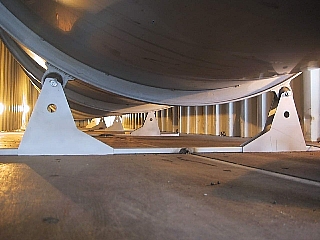 |
| Peter
inserts the muffler tube into the 40 Ft container. |
The bolted down muffler tube. This is
necessary to prevent the tube from buoying upwards in the surrounding
sand bed. Vibrations absorbers insulate the tube from the walls of the
container. |
|
-
FHBB (University of applied science Basel) and
SPL continue their cooperation with two R&D projects:
|
|
| 22. Januray 2003 |
First
firing with the regenerativly cooled 2.5 kN LOX/Ethanol engine! |
Two
students of FHBB
(University of applied
science Basel), Gianni Ermini and Florian Kaiser, finished their
diploma thesis, made in the frame of a research program at SPL and
presented the results in a public exhibition. The focus of their work
was on designing, building and testing of a regenerative cooled
combustion chamber with 2.5 kN/560 lbs thrust (see also the news entry
of 10th November 01).
The students have analysed the heat flux through the chamber walls and
the heat transfer into the coolant (water, kerosene and pure ethanol) .
They have also developed a code to optimise the size and shape of the
cooling channels. Following a low cost approach, the combustion chamber
was made of aluminium. Their diploma thesis can be downloaded here (german!).
In the meantime we at SPL upgraded the test stand, so it is now fully
operational for LOX/hydrocarbon with tank pressures up to 5 MPa.
Finally we successfully fired the chamber 28th December 2002. A
veritable firework for new year's eve and we hope a god omen for the
New Year :-)
In an
ongoing partnership of SPL with FHBB it was decided, that a next step
will be the design of a small, low cost turbopump. The project starts
with a radial inflow turbine derived from a automotive turbo charger.
SPL thanks FHBB, Prof.
Dr. Peter von Böckh and the two students for the
great teamwork! A more detailed description of the engine and tests can
be found here.
|
|
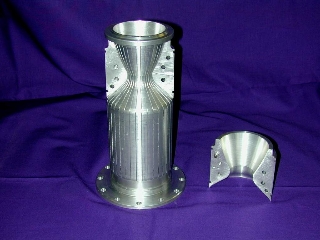 |
| Parts of the combustion chamber. The chamber is
designed to be fully demountable to test various configurations. This
is also important to inspect the liner and its cooling channels after
test runs. Click on the image to enlarge... |
The inner liner with the milled cooling channels.
One of the two halves of the throat closeout has been removed. The
closeout mates very precisely with the liner to prevent any bypass flow
in the throat area. The temperatures in the cooling channels are
measured by thermocouples of 0.5mm diameter that are mounted through
small openings in the outer shell and in the closeout.
A second version of the liner has been machined with more cooling
channels. This will reduce the pressure drop, but results in a lower
velocity in the cooling channels and therefore in a lower heat transfer
as the mass flow of coolant remains the same. Click on the image to
enlarge ... |
 |
|
|
Ignition!
The picture shows a test run under rel. low chamber pressure (o.6 MPa)
using LOX/ethanol at an O/F of 1.3. In this test, the injector was
equipped with only 3 injector elements (see 1st
September 02 and 11th
March 02) . Tests with full chamber pressure of 2.5 MPa will
be conducted as soon as we have finished the muffler system.
4 min hires
Realmedia movie of the event (7.3 Mb) .
4 min lowres Realmedia movie
of the event (2.6 Mb) .
|
An
overview of the test setup. One can clearly see the frozen LOX line and
LOX valve, the regen. chamber with it's feeding lines, the torch
igniter and several thermocouples. The LOX tank is on the top left. |
|
| 1. September 2002 |
Completion
of the LOX/HC engine and test stand in sight |
It seems that our work on the test
stand and the cryogenic equipment to test the 4 kN LOX/HC engine are
coming to a important milestone: The first firing of a LOX/HC engine
with an noteworthy thrust level. This is also a requirement for the
thesis work of our students at FHBB (see also the news entry from 10. November 2001)l. The next
news entry will hopefully show you a complete test setting or even a
working LOX engine :-)
|
|
 |
| The torch igniter (see also news entry from 3. March
2001) fires through the injector plate of the heavy walled 4
kN LOX/HC engine. On the left: the attached copper case of the torch
igniter with the spark plug.A more detailed view of the injector plate
can be found here. |
The LOX-valve as designated on the test stand. The
assembly will be insulated, the extended shaft and actuator will be
heated to prevent them from icing. |
|
| 13. April 2002 |
Latest
firing of the 12 kN TETHIS I Solid Motor |
Saturday
the 13. April, we finished the solid propulsion program with a firing
of the 12 kN TETHIS I motor. The solid program is suspended now, so we
can concentrate our efforts to the liquid biprop development. More
information's (mainly the development of the TETHIS I motor and of
igniters) can be found on the project pages soon. The firing was done
with a configuration of two different propellant compositions:
30 ms
after pressing the red button, the motor delivered full thrust of 12
kN. The new MagTef igniter has done a good job! Virtually no pressure
peaks occurred. No smoking around for half a second like often seen in
HPR rocketry!
|
|
 |
| The motor under full thrust of 12 kN. Peak thrust
was a bit more than expected, the thrust test stand jumped 3 cm (Note:
The thrust test stand is bolted to a concrete block of 2.5 metric
tons!). Click on the image to start a movie 800 kB, needs the latest Real-Player) |
Test stand and motor after firing. More infos about
the test stand can be found here
and here. |
 |
 |
| One of the grain segments. The grain close to the
igniter contains 0.6% CATOCENE burning rate catalyst to improve the
ignitability and to give an initial boost during liftoff. |
We also
tested a new type of igniter made of sintered Magnesium/Teflon used in
the actual test. After only 30 ms (!) the motor reached its full thrust
of 12'000 N without any pressure peaks. |
|
| 11. March 2002 |
Injector
for the heavy walled liquid propellant engine ready |
We have
finished the injector of the heavy-walled modular combustion chamber
(see also the news from 27. July 01
and 18.
October 99). The modular concept of the injector allows
various configurations.
|
|
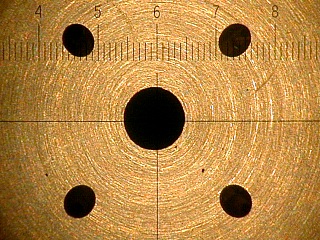 |
| The injector plate with the inserted injector
elements. The element in the center is a Pentad surrounded by six
Triplet injector elements. The elements are made of a
Copper/Chromium/Zirconium alloy. |
A look through a microscope on the central Pentad.
The holes were made by a special deep-hole drilling process to get very
smooth holes and a perfect alignment. Note also the sharp edges and the
absence of any burr. The piece is showed as drilled, no additional
treatment was made. |
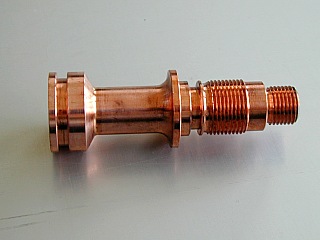 |
 |
| One of the injector elements. The modular design
allows different configurations during the test phase. The final
injector will be a monolithic design made of aluminum. |
A special flow turbine will measure the LOX flow on
the test stand. A magnetical pickup counts the revolutions. |
|
| 10. November 2001 |
Cooperation
between SPL and FHBB goes on with the development of copper combustion
chamber |
|
23.
April 1999 SPL and FHBB (University of
applied science Basel) have concluded their future cooperation. In the
past semesters FHBB has analyzed the behaviour of various
injection-systems in a high-pressure environment (see also the news
entries 23.
April 99, 16.
November 1999, 26.
November 2000 and 23.
January 2001).
Today, we concluded a further partnership to design, build and test a
regeneratively cooled combustion chamber. The students will analyze the
heat flux through the chamber walls and the heat transfer into the
coolant. They will also optimize the size and shape of the cooling
channels. The combustion chamber will consist of a inner copper liner
with machined cooling channels and an outer shell of electro plated
nickel. We are very proud of gaining this partnership!
 |
 |
|
| A
rendering of the inner copper liner of the X-Bow I engine. At the
ground of the cooling channels, the wall's thickness is only about 0.8
mm to get the best heat transfer into the cooling fluid and to minimize
thermal stress |
The
combustion chamber consists of an inner copper liner with machined
cooling channels and an outer shell of electro plated nickel.
The picture shows a detail of a sample cutted out of of the electro
plated combustion chamber wall. |
|
Note: This will be the last news entry until
February 2002 because of the webmasters trip to Australia. Among other
things, he will also participate in the 11th
conference of the Australian Space Research Institute ASRI
(see also the presentation
we gave there).
|
| 14. September 2001 |
SPL is
visiting NERO launch campaign in the Netherlands |
NERO
has organized a launch campaign at ASK (an artillery test area of the
dutch army). SPL took the chance to see all the "northern lights" we
only knew from their web pages, mailing list etc. till then. Thanks
guys, that was a great day!
|
 |
 |
| |
The picture shows a rocket powered by a KN/Sorbitol
motor. It was build by the belgium amateur group VRO.
The start was perfect but the recovery system failed :-( |
The SSRV-1 (Small Scale Research Vehicle
1) build and flown by the danish group DSC.
The motor was also a "Candy"-Motor. The rocket also had a video
downlink. The above picture was taken from the DSC
home page with their permission. |
|
| 13. April 2001 |
First
shot on the new test stand with a hot water motor |
To consecrate our new test
stand, we mounted a hot water rocket motor on the test table.
This motor is a remnant from a former project (JATO). The vessel is
rated up to 6 MPa by national vessel authorities. Special thanks to Mr.
André Hool who made the motor available to us.
|
|

|
| The test stand mounted on a concrete block of 2.5
metric tons. In front the regulator for the 3 x3 kW heating cartridges.
Close to the nozzle one can see the security valves and the pilot valve
for the nozzle's internal valve. |
A view into the nozzle (20 mm diameter) with its
integrated valve. |
|
|
 |
| Hansueli Ammann just pushed the red button. All the
equipment is certified by the national authorities, so it shouldn't be
dangerous standing beside of it. |
The Thrust curve at a hot water/steam pressure of 4
MPa. The peak at the beginning is the result of sloshing water during
opening the nozzle's valve. |
|
^ top
|
|
|

